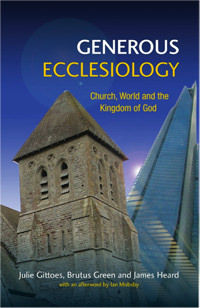6th October, 2015
Julie Gittoes, Brutus Green and James Heard (eds)
Generous Ecclesiology: Church, World and the Kingdom of God
SCM Press, London, 2013
ISBN-13: 9780334046622
 |
|
"Generous Ecclesiology needs to be generous not just within the streams of the church, but generously engaging with where God is active in local and global cultures." |
Mission-Shaped Church (2004) is the Church of England report that called for Fresh Expressions of church to respond to a changing cultural context and networked society. It urged championing an innovative range of different ways of doing church in a “mixed economy” alongside existing parishes, training a new breed of pioneering leaders, and making church accessible to unchurched people.
For the Parish (2010) is a critical response that defends the parish church as a basis for mission and upholds the importance of inherited worship patterns. The debate can be polarising and adversarial, often along evangelical-catholic lines. This volume calls for a more generous approach in appreciating the need for ecclesiology and missiology, inheritance and innovation, redemptive and incarnational theology, and engagement with liturgy and the world.
Ten diverse writers grapple with issues raised by Mission-Shaped Church and For the Parish, drawing on their experience in parishes, diocesan leadership, Fresh Expressions and chaplaincies. Stephen Conway advocates a refocusing of the bishop’s apostolic-prophetic role in mission for the sake of those in the diocese outside church circles, and not being preoccupied with administrative and maintenance matters. We need this reframing not just for Anglican bishops but for leaders of other denominations and networks.
Jeremy Morris traces the origins of Anglican social witness in the mid-nineteenth century and its interest in incarnational engagement with society and politics. Anglo-Catholic tradition stressed that the church’s relationship with the most vulnerable in society was reflected in the quality of worship. Bishop of Zanzibar Frank Weston said famously to the 1923 Anglo-Catholic Congress: “You cannot claim to worship Jesus in the Tabernacle if you do not pity Jesus in the slum”. Incarnational witness and radical experimentation in mission are not new, nor the prerogative of a particular church stream. There is much to learn from our traditions and history.
The challenge of inculturation is to be innovative for the missional context while being faithful to Scripture and tradition. James Heard discusses what this means for Anglican churches wanting to be faithful to their heritage while also communicating their faith afresh to a new generation. Mission-Shaped Church might stress the need for innovation and For the Parish stresses fidelity to tradition, but in a generous ecclesiology they are better together.
Brutus Green advocates a more positive view of contemporary culture and technology (in contrast to the defensive critical view of For the Parish), without compromising to its values (as some suggest Mission-Shaped Church does). Generous Ecclesiology needs to be generous not just within the streams of the church, but generously engaging with where God is active in local and global cultures.
Julie Gittoes explores Don Hardy’s metaphor of church as “careful walking” that is both formed by worship and embodied by expressing its witness through its wandering and spread-out-ness in the world. The church becomes and lives up to being the church as it imitates and embodies Jesus and his mission “on the road”.
The Wesleyan doctrine of assurance, suggests Tom Greggs, has implications for defining church as intrinsically overflowing in love for others in compassionate service. When I became a Christian, my first prayer was for assurance, “Am I really saved?”. When I planted a missional house church, one of our first questions was “are we really church?” Validation comes not from our imagination and interiority, but whether we are focused out from ourselves and to others as a result of the Spirit’s work.
As a hospital chaplain, Robert Thompson argues that Mission-Shaped Church and For the Parish both need more sensitivity to people of all faiths – or none – who still deserve our compassion and care. He suggests an image of the church as “Christ’s Holy/Sick Body” and our need for repentance and healing. Thompson appeals particularly for attention to issues of prayer, gender/sexuality and money, arguing if we do not address these issues we will find it increasingly difficult to be heard on other matters that reflect the generosity of God’s reign.
God expressed boundless love for the world on the cross, and Jonathan Clark urges the church to reflect that with radical inclusion as a community as well as being exclusively committed to Christ. He admits this is a process. Ideally the church is “one, holy, catholic and apostolic” but in reality it is also “plural, fallen, squabbling and inward-looking”. The closer we get to Jesus’ world-embracing perspective from the cross, the more inclusive and generous we will become.
Mission-Shaped Church is a challenge for the church to engage the Western world with creative mission initiatives. The critical response of For the Parish is also worth hearing for its appeal for attention to being grounded in the local parish, and for fuelling our mission with worship and liturgy. To address the challenges of mission in the Western world, we need attention to both missiology and ecclesiology. The issues raised in Generous Ecclesiology, and the generous dialogue it models, will be of particular interest to Anglicans and especially those following the Mission Shaped Church and For the Parish conversations. Its broader relevance is for church leaders who are navigating how worship and mission (and engagement with liturgy and the world, tradition and innovation, and ecclesiology and missiology) are better together.
This review was originally published in Australian eJournal of Theology 22:2 (2015), pp. 148-149, accessible at http://aejt.com.au/2015/volume_22/vol_22_no_2_2015/?article=773414
Follow this link to buy this book – Generous Ecclesiology: Church, World and the Kingdom of God.
FOR MORE ON BOOKS, visit our books page here…
FOR SIGHT’S BOOKSHOP, visit here…






